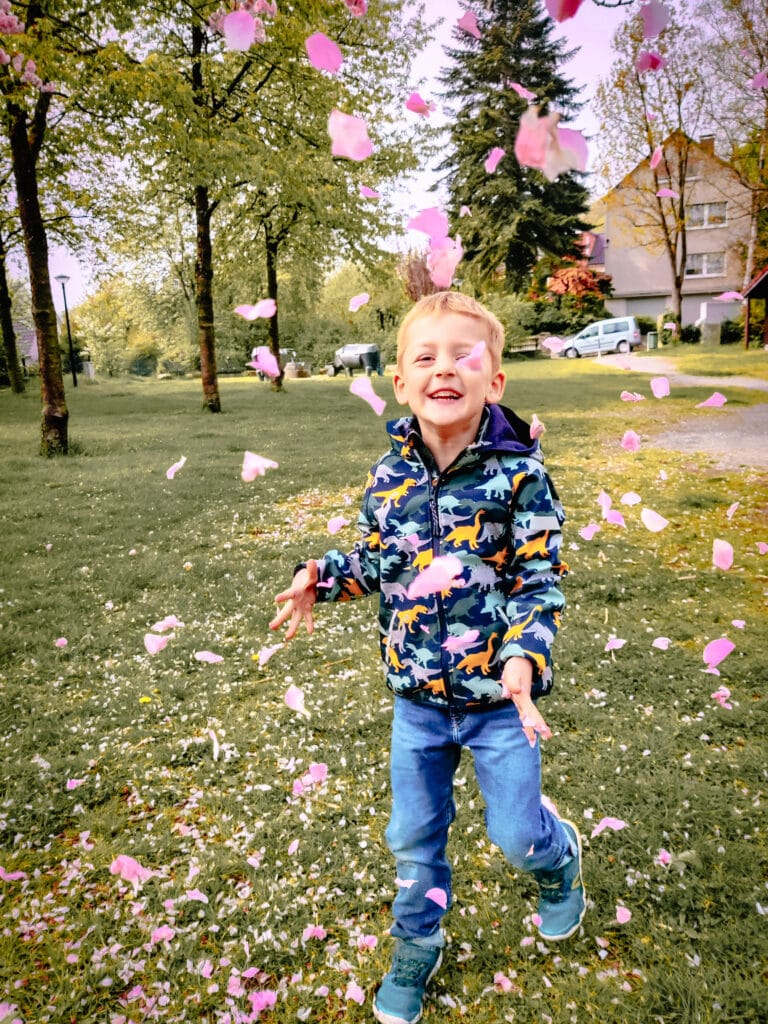Tips & Tricks
Tips & tricks for everyday life
- Give your child your undivided attention and time as often as possible with intensive attention, lots of physical contact and loving closeness.
- Plan and keep rituals such as eating together, game nights and reading stories aloud to go to sleep.
- When eating together and during a conversation, digital media should have a break.
- Out of sight out of mind: Even a cloth in front of the TV helps to bring the device out of the consciousness of small children.
- All mobile screen devices and the remote control should be out of sight and reach of the little ones.
- Let your child take part in everyday activities (cleaning, cooking, doing the laundry) and show them that they can also take responsibility.

Alternatives to screen media
- Children enjoy doing and participating in what their parents do – it can even be very educational.
- Various everyday objects can become a microphone, a hand puppet or other things.
- Unpacking and putting away as well as searching and finding in the household are satisfying activities.
- Different things and people can be listed, such as the number of people at the table to set it together.
- When dealing with the laundry, clothes pegs can be turned into fantasy creatures, the different fabrics can be felt and dressed up.
- The sense of responsibility can be developed and strengthened by watering flowers or looking after animals.
- They can make a list of things to do, which lowers the threshold for putting them into action: special playgrounds, forest, meadow, water, farm and animal enclosures as well as accessible parent-child activities.
- With storytelling, guessing and finger games, waiting times can become attention and play times.
- Through interaction and resonance by the parents, knowledge and feelings are conveyed to children, which is disturbed by the distraction of the other person, e.g. through media.
Media balance and recommendations
Maximum daily screen time for children
- 0-3 years = no screen media.
- 3-6 years = max. 30 minutes and only together with parents. At this age, it is still best to have no screen time at all.
- 6-10 years = max. 45-60 minutes and best only together with parents.
Shared screen time for families with children aged 3 and over.
The best is still: no screen time.
- Choose age-appropriate formats and pay attention to the content.
- After watching TV, take time to discuss and reflect together on what you have seen.
- Plan time (at least 30 minutes) for games and conversation after using screen media and before going to sleep.
Control your own media use
- Consciously set aside media time for music, to watch a film or to work or play on the computer. Try to keep to the time and turn off the device afterwards.
- Become aware of time wasters, e.g. deactivate the autoplay function on YouTube, Netflix etc., set yourself (time) limits.
- Look at the personal usage times of individual apps and try to reduce where it makes sense. You can also create a usage timer for individual apps so that the app can no longer be opened after the set time has elapsed.
- Also try the black and white mode on your smartphone, which will immediately make it less attractive.
- All mobile screen devices and also the remote control should be out of sight and reach of the little ones.
- Use screen media when the child is asleep or away from you for other reasons.
- Do not allow screen media and distracting noises to run in the background.
- Leave your smartphone at home when you go out in nature with your child.
- Be a role model for your child!
- After watching TV, take time to discuss and reflect on what you have seen together.
- Plan time (at least 30 minutes) for games and conversation after using screen media and before going to sleep.
Here you will find more suggestions if you have to spend or have spent the whole day in front of the screen: Flyer Mediafasting
Resources
Parents’ letters
- Subscribe to the “Screen-free to 3” parents’ newsletter and be informed when the new parents’ newsletter is available and provides you with interesting topics about “Screen free until 3” as well as other helpful tips & tricks.
- The parents’ letters are there to support you and your child during the first 3 years of life.
Digital weaning
- Leave your smartphone at home when you go out into nature.
- Create screen-free zones, such as the children’s room and bedroom.
- Put your smartphone on silent to avoid being disturbed and answer messages at agreed media times.
- FREE DAYS: Set aside one day a week when you do not use digital screen media.
- Get outside as much as possible and enjoy nature.
